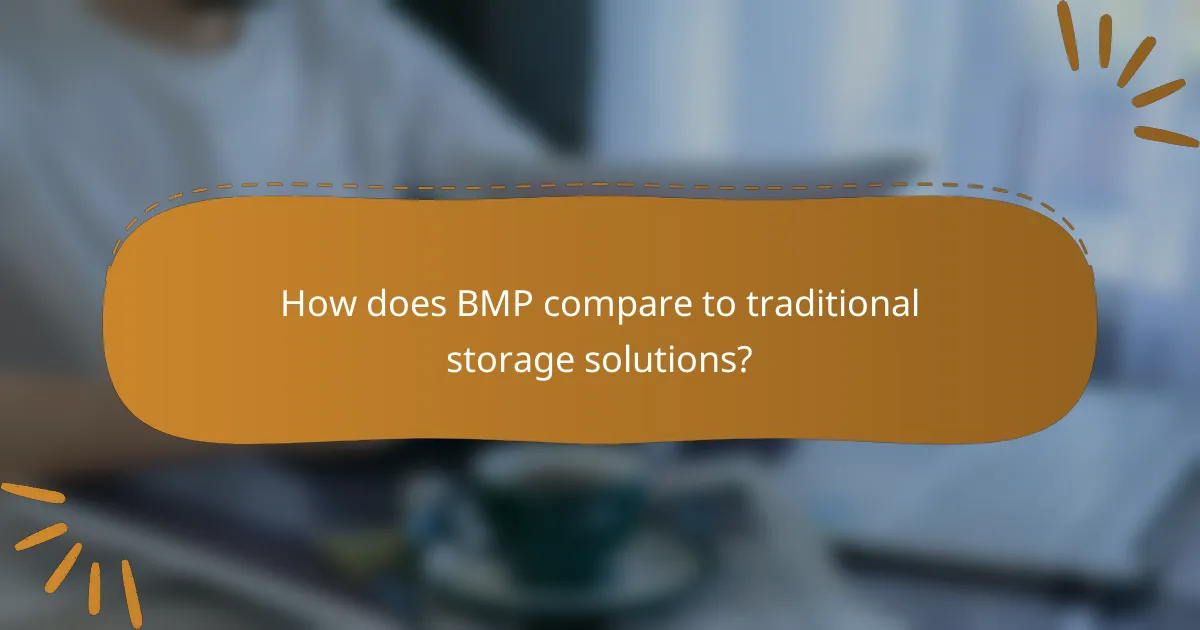BMP storage solutions are designed to provide high capacity, reliability, and seamless compatibility with existing systems, making them ideal for businesses. Leading providers like Western Digital, Seagate, and Toshiba offer a variety of options tailored to diverse storage needs and budgets. With advanced data management techniques, BMP ensures data integrity and performance optimization, while its straightforward structure allows for easy use across multiple platforms without extensive conversion processes.

What are the best BMP storage solutions for businesses?
The best BMP storage solutions for businesses prioritize high capacity, reliability, and compatibility with existing systems. Solutions like Western Digital, Seagate, and Toshiba offer robust options that cater to various storage needs and budgets.
Western Digital Ultrastar DC HC550
The Western Digital Ultrastar DC HC550 is designed for data centers requiring high-capacity storage. With capacities reaching up to 18TB, it provides a balance of performance and efficiency, making it suitable for both cloud and enterprise applications.
This hard drive utilizes a helium-sealed design, which reduces turbulence and improves power efficiency. Businesses should consider its 7200 RPM speed and SATA interface, which ensure compatibility with most server environments.
Seagate Exos X18
The Seagate Exos X18 is another excellent choice, offering up to 18TB of storage with a focus on enterprise-level performance. Its design supports heavy workloads, making it ideal for applications like big data analytics and cloud storage.
Featuring a 7200 RPM speed and a SAS interface, the Exos X18 ensures high data transfer rates and reliability. Companies should note its advanced power management features, which can help reduce operational costs over time.
Toshiba MG08 Series
The Toshiba MG08 Series provides a competitive option with capacities up to 16TB, designed for high-density storage environments. It is particularly well-suited for cloud storage and large-scale data centers.
This series employs a 7200 RPM speed and SATA interface, ensuring broad compatibility. Businesses should consider its robust error recovery features, which enhance data integrity and reliability in critical applications.

How does BMP ensure high-quality storage?
BMP ensures high-quality storage through advanced data management techniques that prioritize reliability and efficiency. By utilizing robust algorithms and error-checking mechanisms, BMP maintains data integrity while optimizing performance across various applications.
Data integrity features
BMP incorporates several data integrity features to safeguard stored information. These include checksums and redundancy measures that detect and correct errors, ensuring that data remains accurate and accessible over time. Regular validation processes further enhance reliability, making BMP suitable for critical storage needs.
Additionally, BMP supports various file formats and standards, allowing for seamless integration with existing systems. This compatibility reduces the risk of data loss during transfers and conversions, contributing to overall data integrity.
Performance benchmarks
Performance benchmarks for BMP highlight its efficiency in data retrieval and storage operations. Typically, BMP systems achieve response times in the low tens of milliseconds, making them suitable for both consumer and enterprise applications. These benchmarks are crucial for users who require quick access to large datasets.
When comparing BMP to other storage solutions, it often outperforms traditional methods in speed and reliability. Users should consider their specific performance needs and choose BMP configurations that align with their operational requirements for optimal results.

What makes BMP compatible with various systems?
BMP files are compatible with a wide range of systems due to their straightforward structure and adherence to common standards. This compatibility allows BMP images to be easily utilized across different platforms and applications without the need for extensive conversion processes.
Supported file systems
BMP files can be stored on various file systems, including FAT32, NTFS, and exFAT, which are commonly used in Windows environments. These file systems support the large file sizes that BMP images can occupy, making them suitable for high-resolution graphics.
Additionally, BMP files are compatible with UNIX-based systems like ext4, allowing for cross-platform usage. This flexibility ensures that users can work with BMP images regardless of their operating system.
Integration with cloud services
BMP images can be easily integrated with popular cloud services such as Google Drive, Dropbox, and OneDrive. These platforms support BMP file uploads and provide seamless access across devices, enhancing collaboration and storage options.
When using cloud services, consider file size limitations and upload speeds, as BMP files can be larger than other formats like JPEG or PNG. Users should ensure they have adequate storage space and a reliable internet connection for optimal performance.

What are the key benefits of using BMP storage?
BMP storage offers high-quality data management with simplicity and broad compatibility. Its design ensures efficient storage solutions that cater to various needs, making it an attractive option for both individuals and businesses.
Scalability options
BMP storage provides flexible scalability, allowing users to adjust their storage capacity based on current demands. This means you can start with a smaller setup and expand as your data grows, making it suitable for both small projects and large enterprises.
For example, a small business might begin with a few terabytes and scale up to petabytes as their operations expand. This adaptability helps avoid over-investment in unnecessary storage resources.
Cost-effectiveness
One of the main advantages of BMP storage is its cost-effectiveness. By utilizing a pay-as-you-go model, users can manage their expenses more efficiently, only paying for the storage they actually use.
Additionally, BMP storage often reduces the need for expensive hardware upgrades, as it can be integrated with existing systems. This can lead to significant savings, especially for startups and small businesses operating on tight budgets.

What criteria should be considered when selecting BMP storage?
When selecting BMP storage, consider capacity, performance, and compatibility with existing systems. These factors ensure that the storage solution meets your needs for efficiency and reliability.
Capacity requirements
Capacity is a critical factor in BMP storage selection. Assess your current and future data needs to determine the required storage size, typically ranging from hundreds of gigabytes to several terabytes. It’s wise to choose a solution that allows for scalability to accommodate growth over time.
Consider the type of data being stored, as different formats may require varying amounts of space. For instance, high-resolution images or videos demand more storage compared to standard text files. Always factor in a buffer for unexpected increases in data volume.
Performance specifications
Performance specifications dictate how quickly and efficiently data can be accessed and processed. Look for storage solutions that offer low latency, ideally in the low tens of milliseconds, to ensure rapid data retrieval. High throughput is also essential, especially for applications that require large data transfers.
Evaluate the read and write speeds of the storage system, as these will impact overall performance. For example, SSDs generally provide superior performance compared to traditional HDDs. Ensure that the chosen storage meets the demands of your applications without bottlenecks.

How does BMP compare to traditional storage solutions?
BMP, or Bitmap Image Format, offers advantages over traditional storage solutions by providing high-quality image storage with simplicity and broad compatibility. It is particularly effective for applications requiring detailed graphics, making it a preferred choice for many users.
Speed and efficiency
BMP files are typically larger than compressed formats, which can affect speed and efficiency in terms of storage and transfer. However, their uncompressed nature allows for faster access times since there is no need for decompression, making them ideal for applications where speed is crucial.
For example, in graphic design and professional photography, BMP files can be opened and edited quickly, saving time during workflows. Users should consider their specific needs; if speed is a priority and storage space is less of a concern, BMP can be a suitable choice.
Reliability and durability
BMP files are known for their reliability due to their uncompressed format, which preserves image quality without loss. This makes them durable for long-term storage, as they do not degrade over time like some compressed formats might.
When storing critical images, such as medical scans or archival photographs, BMP ensures that the original quality remains intact. Users should ensure proper backup solutions are in place, as the larger file sizes can lead to increased storage costs, but the trade-off in quality often justifies this investment.

What are the emerging trends in BMP storage technology?
Emerging trends in BMP storage technology focus on enhancing data management efficiency, increasing compatibility across platforms, and integrating advanced features like AI. These developments aim to simplify user experience while ensuring high-quality storage solutions that meet evolving demands.
AI integration for data management
AI integration in BMP storage technology streamlines data management by automating processes such as data classification, retrieval, and analysis. This allows organizations to efficiently handle large volumes of data while minimizing human error and resource expenditure.
For instance, AI algorithms can predict data usage patterns, enabling proactive storage allocation and reducing costs. Companies can implement AI-driven tools to monitor storage health and performance, ensuring optimal operation and timely maintenance.
When considering AI integration, businesses should assess their specific needs and the potential return on investment. It’s crucial to choose solutions that align with existing infrastructure and offer scalability to adapt to future growth.
